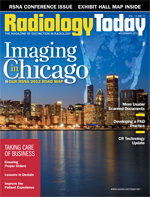 November 2012
November 2012
Focus on the Patient Experience
By John Micallef, RT(R), MHA
Radiology Today
Vol. 13 No. 11 P. 8
To stay successful, an imaging department’s staff and management need to understand their roles in the relationship with the hospital or imaging center they serve. Those roles essentially become the team’s professional identity, but defining that identity is no easy task.
A good place to start when establishing, evaluating, or adjusting this definition is to consider how others would respond when asked questions about their interactions with and service from staff and physicians in the radiology department. Do they work together as a team? Does imaging act as separate department unto itself or does it act as if it shares a common goal with the whole institution?
One key to successful departmental operations is clear communication of the common goal: to take care of the patient from the point of registration to the end of his or her exam. Many patients in imaging centers and specialty hospitals today are moved from place to place during care. This can be confusing and inefficient for both employees and patients. Making these transitions as smooth and coordinated as possible promotes quality care and a positive patient impression.
How smoothly these transitions are made reflects on how the process of communication is set up within the department. Patients are becoming more and more educated about their health and more astute as to how they should be treated when receiving medical care. Interactions among front-desk personnel, technologists, and physicians should appear seamless in the patient’s eyes. More than just a simple handoff, it needs to be a transaction of professionalism and courtesy. Evaluate whether there may be a patient flow issue in your facility’s workflow and address it by utilizing some of the following techniques:
• Take time to review proper techniques for moving a patient through the department. Exercises should be completed to ensure that the staff understands the different scenarios. Mock patient transfers should be conducted at least quarterly to assure that nothing is left to chance. Not only is this an important part of how your department is viewed throughout the organization, but it establishes the importance of teamwork within your department.
• Establish a team coordinator to set up these drills. Rotate this role to get a fresh perspective on ideas. Giving this task to someone who may not be in a managerial role can potentially bring out undiscovered management characteristics. It also establishes the ability to think outside the box and create new ideas for the department. By creating this team “champion,” you create a sense of pride and accomplishment among your staff members.
• Establish a competitive system that rewards employees for new ideas that move patients through the department effectively. These all add to an approach of getting your staff to work effectively together in a way that directly affects the patients and hospital.
• Attempt to collect data from these exercises so management can review what works and what doesn’t. Either way, a valuable lesson may be learned on which future exercises can be built. Variations will likely occur when trying these exercises, but understanding them will certainly advance the overall goal of improved patient flow and satisfaction.
Patient Experience Matters
Patients have many choices today regarding where they can undergo a procedure. It is critical to make sure that a patient feels confident that his or her exam was done properly, on time, and with personal consideration from the staff. A patient’s perspective on the experience can resonate throughout an institution several ways, including the referral of other patients, willingness to pay bills on time, and opinions on physicians and staff who provide services.
If at all possible, involve upper management to assist in driving these initiatives. Such involvement reinforces to the staff that service is truly a vital part of the institutional image and mission, showing everyone the importance of working together to improve overall flow.
As healthcare professionals, we can understand the importance of patient-driven satisfaction to the overall success of our departments, but it still requires some planning and training to implement it and help our institutions retain patients and advance the ultimate purpose of taking care of our patients and growing our business.
— John Micallef, RT(R), MHA, is director of imaging services at Karmanos Cancer Center in Detroit. He also serves on the board of InterMedCorp, a medical billing and consulting company, and has presented nationally and internationally on radiology and hospital operations and strategies.

